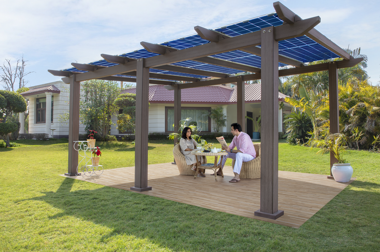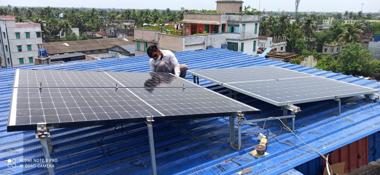

Happy Sustainable Homes
Solar Rooftop Plant at your home


touch with you










B E N E F I T S
T E S T I M O N I A L S
“HomeScape is a dream come true rooftop solar solution. It has brought to life my idea of organic food and green electricity under one roof.”
Rita Nahata
Owner Amrit Farms, Delhi
“Have installed Solar plant recently and I am very much impressed with the service you are providing. Keep up the good work and keep helping people to save money.”
SHRI Rajendra
Modi, Pratap Nagar, Bhopal
“From professional guidance, chic design, excellent finish to cutting down my electricity bill through clean energy, HomeScape is an amazing experience.”
Uma Gajapati Raju
Former Member of Parliament
"I was doing research about investment for long time and during this research I came to know about solar energy, when Loom Solar team explained about 10 to 15% annual return, I was impressed with this benefit and installed the system"
Surendra Kumar
Badarpur, New Delhi
S U P P O R T
Moving towards Sustainable Energy will not only Substantially contribute towards energy conversation, reduced bills but will also boost up the morale in many aspects:
– Solar Is the Future; Generate your own power by Soaking the Sun.
– Say Good Bye to immensely high bills.
– Contribution towards the environment.
– A Investment with lucrative returns and Increases the value of your property
– Easy maintenance and a long-term solution
If your roof is not having any shade from adjacent buildings, trees etc., made of RCC and its structure is not delicate then your roof is suitable for installation of a solar plant.
This would depend on various factors such as the shadow-free area available, the orientation of the roof etc., however, as a thumb rule, we can assume 1KW plant requires 12 sq. meters (120-130 sq ft) of shade-free area.
A 7kW to 10kW plant would suffice for a house with an electricity consumption of 800-1200 units a month.
Amplus uses non-penetrating structures which are mounted without any puncturing. In case any insertions are needed, we use chemical agents which guarantee waterproofing and no leakages. Thus, the integrity of the roof is maintained. The load of the entire solar plant is about 10-15 kg/square meter and can easily be taken by any roof.
No, you can install solar if you stay in an independent house.
Technically yes, a solar plant can meet your entire power requirement if it is backed by the battery energy storage system (BESS). But practically, where the power requirement is higher it would be recommended to use solar in sync with the grid. When in sync, priority is automatically given to the solar power to be consumed first.
On an average, every 1 KW setup produces 1300 to 1500 units in a year. This may, however, vary based upon the location of the plant, seasonal factors, surroundings and shadow-free area available.
The Solar plant will generate electricity only during the sunny hours, typically between 6am to 6pm and will not generate any electricity during the night.
Output from Solar PV system is dependent on intensity of light and duration of the day. In rainy and winter seasons, output is slightly lower but still the system works smoothly as sunlight is available most of the time.
The RoI lies in the 15%-30% depending on the system size and the structure you decide to install. Our 10kW product will help you save around Rs.45 lakhs in its lifetime.
The panels come with 25 years warranty. 10 years for 90% performance and subsequent 15 years for 80% performance, the inverters come with a 5 year warranty which can be extended by AMC. We have AMC packages which cover upto lifetime of the product. You can purchase to safeguard your entire system.
A solar system requires minimal maintenance as there are no moving parts. While panels come with 25 years warranty, individual components have different warranties. Regular cleaning of the panels, once in 15 days, is enough for optimal performance of the system.
You’ll need to have a site approval, feasibility test, and net-metering agreements with the DISCOM. The approvals vary from state-to-state. All the applications and approvals are covered by us.
You can either pay upfront for the system or pay in EMIs starting at Rs.3040/month for a 3kW Atrium.
PV, short for Photovoltaic, derives its name from the process of converting light (‘photo’) directly into electricity (‘voltaic’). Simply put, a Solar PV system is a power station that generates electricity from sunlight. The main components of a Solar PV system are:
Solar Panels or Modules: Solar panels consist of a group of small cells made from semiconductor material. When the sun’s light falls on the modules, it excites the electrons, thereby creating direct current (DC).
Solar Inverter: The DC electricity goes into an inverter that converts it into alternating current (AC). We use AC for running our household or office or factory equipment.
Meters: Solar meter to calculate the output of the system. Net-meter or bi-directional meter which is used in a grid-tied system. Net meter calculated the total unit imported from the grid.
Grid Tied System
This system works only with the electricity grid without batteries. Although, this system has no power back-up but is much cheaper and has no recurring cost. Government backed subsidies reduce the cost further. This system is ideal for cities where there is little to no power cut.
Off Grid System
This system works without the electricity grid and has power backup options. This is ideal for cities where there is no connection to the grid and places with frequent power outages.
Hybrid System
As the name suggests, it is a combination of Off Grid and Grid Tied system. It works as a Grid Tied system when electricity is available and works as Off Grid in case of power cut. It has batteries to store energy. It is the most expensive of the 3 systems. It is ideal in cities where there are frequent power cuts.
Net-metering is a principle through which your electricity units are counted by subtracting the number of units you fed back to the grid from the total number of units you consumed from the grid. Your solar system generates electricity units which, if used, reduce the electricity import from the grid thereby reducing your total count of grid units consumed, and, if not used, are fed back to the grid which reflects in your electricity bill as reduction in the number of units consumed. We have a unidirectional electricity meter installed in our homes. A net-meter is a bidirectional meter which moves according to the grid units being imported and renewable energy being exported to the grid.
A solar rooftop is an electric power station that produces solar energy using photovoltaics.
The benefits of an on-grid solar rooftop system are guaranteed 24/7 electricity, more savings, good investment returns, high efficiency, easy installation, affordability, and low maintenance.
Installing a 10kW rooftop solar system is equivalent to planting 8600 saplings over a lifetime of 25 years.
Solar rooftops have multiple advantages and have proven to be the most efficient power alternative for Indian homes and establishments. They are sustainable, require no land use, reduce distribution losses, and enable better transmission.
Also known as Rooftop Photo-Voltaic Power Station or PV System, a solar rooftop is an electric power station that generates usable solar energy using photovoltaics. They are set up on the rooftop of any commercial, residential, institutional, or industrial building and are mainly of three types:
With more and more people turning towards solar panel roofs because of its lucrative advantages, the rooftop solar market has seen exceptional growth. The solar rooftop system has turned out to be one of the most feasible, sustainable, and dependable modes of power generation. Given below are the top benefits of solar rooftop system:
Installation of solar panels just requires 7 super easy steps, and they are as follows:
All three types of solar panels work differently.
On-grid solar rooftop system
The solar panels absorb the rays of the sun and convert them into electricity. Then, the solar inverter converts the direct current into the alternating current. Afterward, the alternating current is fed to the main grid, which is responsible for supplying electricity.
Off-grid solar rooftop system
An off-grid solar rooftop system operates on its own with a battery. The solar panels generate solar power that then charges the battery, which powers several electric appliances.
Hybrid solar rooftop system
The solar panel is interconnected with the inverter, which is further connected to the main grid and the solar battery. The solar panel converts the sun rays into direct current, which is then converted into alternative current by the solar inverter.


















